

REST API Reference. StackMob's API is REST based.
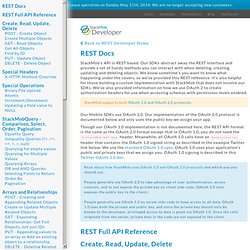
Our SDKs abstract away the REST interface and provide a set of handy methods you can interact with when deleting, creating, updating and deleting objects. Oauth. - The RESTful cookbook. Iteratees in Big Data at Klout « Klout Engineering. Best Practices for Designing a Pragmatic RESTful API. Web framework benchmark. Play lags others significantly. Play framework claimed performance not upto par. Recently, an independent group of people ran a comprehensive test comparing various frameworks under real-world production scenarios and posted the results to Hackernews.
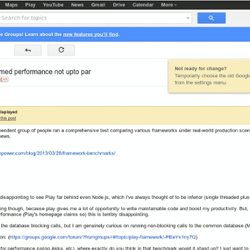
It was thoroughly disappointing to see Play far behind even Node.js, which I've always thought of to be inferior (single threaded plus javascript sucks for large projects). [2.0-Scala] Non-blocking database access. ThreadPools. Play framework is, from the bottom up, an asynchronous web framework.

Streams are handled asynchronously using iteratees. Thread pools are tuned to be low, in comparison to traditional web frameworks, since IO in play-core never blocks. Using Amazon S3 for File Uploads with Java and Play 2. Java play s3 Table of Contents Using a storage service like AWS S3 to store file uploads provides an order of magnitude scalability, reliability, and speed gain than just storing files on a local filesystem.
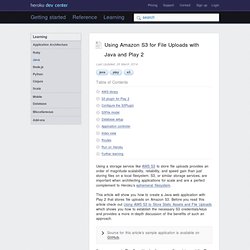
Distributed Caching with Memcached. Memcached is a high-performance, distributed caching system.
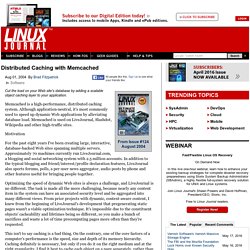
Although application-neutral, it's most commonly used to speed up dynamic Web applications by alleviating database load. Memcached is used on LiveJournal, Slashdot, Wikipedia and other high-traffic sites. For the past eight years I've been creating large, interactive, database-backed Web sites spanning multiple servers. Approximately 70 machines currently run LiveJournal.com, a blogging and social networking system with 2.5 million accounts. In addition to the typical blogging and friend/interest/profile declaration features, LiveJournal also sports forums, polls, a per-user news aggregator, audio posts by phone and other features useful for bringing people together. CoffeeScript.
HyTech – OAuth2: The Resource Owner Password Flow. The third OAuth2 flow that we’ll cover as part of this series is the Resource Owner Password Flow.

We’ve covered the OAuth2 Authorization Grant Flow and the OAuth2 Implicit Flow so far. We’ve also seen how client applications can refresh expired access tokens. The Resource Owner Password Flow is really pretty simple, as it allows the client to exchange a user’s username and password for an access token. Woah….. what? Yes, it means the client applications, let’s say an Android app will really need ask for the username and password. Andreassolberg/jso. Api - How do I implement secure OAuth2 consumption in Javascript. HyTech – OAuth2: the Implicit Flow, aka as the Client-Side Flow. In this part of the OAuth2 series we’ll be looking at the Implicit Flow, which is also known as the Client-Side Flow.
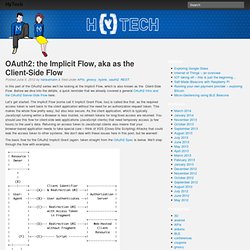
Before we dive into the details, a quick reminder that we already covered a general OAuth2 Intro and the OAuth2 Server-Side Flow here. Let’s get started .The Implicit Flow (some call it Implicit Grant Flow, too) is called like that, as the required access token is sent back to the client application without the need for an authorization request token. This makes the whole flow pretty easy, but also less secure. As the client application, which is typically JavaScript running within a Browser is less trusted, no refresh tokens for long-lived access are returned.
You should use this flow for client-side web applications (JavaScript clients) that need temporary access (a few hours) to the user’s data. Using OAuth 2.0 to Access Google APIs - Google Accounts Authentication and Authorization. Basic steps All applications follow a basic pattern when accessing a Google API using OAuth 2.0.

At a high level, you follow four steps: 1. Obtain OAuth 2.0 credentials from the Google Developers Console. Visit the Google Developers Console to obtain OAuth 2.0 credentials such as a client ID and client secret that are known to both Google and your application. The Stateless Blog - JSON Linking with HAL. Since the discussion about links in JSON seems to be opening up, I thought I would briefly explain my take on linking with JSON and how that presents itself in the design of HAL.
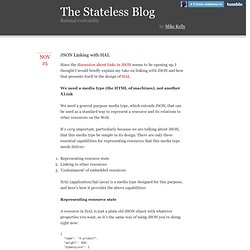
We need a media type (the HTML of machines), not another XLink We need a general purpose media type, which extends JSON, that can be used as a standard way to represent a resource and its relations to other resources on the Web. It’s very important, particularly because we are talking about JSON, that this media type be simple in its design. There are only three essential capabilities for representing resources that this media type needs deliver: Representing resource stateLinking to other resources'Containment' of embedded resources HAL (application/hal+json) is a media type designed for this purpose, and here’s how it provides the above capabilities: Representing resource state.
API Design: Third Edition (video & slides) API docs. The Bigcommerce Stores API is a uniform interface to the resources and events that represent the activity of merchant stores on our platform.
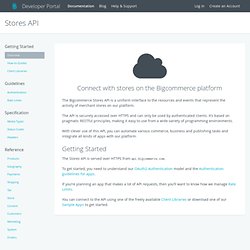
The API is securely accessed over HTTPS and can only be used by authenticated clients. It’s based on pragmatic RESTful principles, making it easy to use from a wide variety of programming environments. With clever use of this API, you can automate various commerce, business and publishing tasks and integrate all kinds of apps with our platform. The Stores API is served over HTTPS from api.bigcommerce.com. To get started, you need to understand our OAuth2 Authentication model and the Authentication guidelines for apps. If you’re planning an app that makes a lot of API requests, then you’ll want to know how we manage Rate Limits. You can connect to the API using one of the freely available Client Libraries or download one of our Sample Apps to get started.
Developer Site. HubSpot currently offers two types of API authentication: OAuth and API Key access. All API users are encouraged to use OAuth for security purposes, and app developers are required to do so if your app is public and listed in the HubSpot App Marketplace. If you're developing internally for your organization, you can generate a HubSpot API key here. Note the difference between using OAuth and API keys in your calls, which is simply a difference in the authentication parameter used in your calls: For OAuth: &access_token=TOKEN For API Keys: &hapikey=KEY HubSpot currently offers three editions: Basic, Professional, and Enterprise.
Mashery Developer Blog. Seamless Integration of RESTful Services into the Web of Data. Journal/ijwest/papers/4113ijwest03.pdf. Docs/dojox/rpc/smd.rst at master · dojo/docs. Bamboo REST Resources - Bamboo Development. WhhD1.png (2200×1683) Can I use Cross-Origin Resource Sharing. Crossing the Streams: Handling cross-site API requests (JSONP, CORS, UMP and more)
My earlier post "Not using JSON and JSONP? You're doing it wrong! " generated a lot of questions about the best ways to handle cross-site API requests from JavaScript running in the browser. API Requests with JSON. To make our JSON format easy to use despite this, we modified our schema for JSON requests. So, when you see XML output in our documentation, you will need to translate it in your mind to the appropriate schema when using JSON.